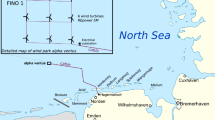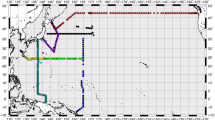Abstract
Acoustic sounder observations of thunderstorm density currents reveal a complicated but ordered internal structure. Fast-response anemometers on a 150-m tower reveal a succession of internal shear layers which occur following the leading portion or nose of the current. The measured wind shear revealed by the anemometers is found to be a function of the temperature differential between the ambient air and the interior of the gust, measured near the surface. An heuristic model is developed to explain this observation.
This is a preview of subscription content, access via your institution
Access options
Subscribe to this journal
Receive 51 print issues and online access
$199.00 per year
only $3.90 per issue
Buy this article
- Purchase on Springer Link
- Instant access to full article PDF
Prices may be subject to local taxes which are calculated during checkout
Similar content being viewed by others
References
Snyder, C. T., Analogue study of longitudinal response to wind shear and sustained gusts during landing approach (NASA TN D-4447, Ames Research Center, Moffett Field, California, 1968).
Neff, W. D., Quantitative evaluation of acoustic echoes from the planetary boundary layer (NOAA Tech. Rep. ERL 322-WPL 38, Environmental Research Laboratories, Boulder, Colorado 1975).
Benjamin, T. B., J. Fluid Mech., 31, 209–248 (1968).
Goff, R. C. Thunderstorm-outflow kinematics and dynamics (NOAA Tech. Memo. ERL NSSL-75, National Severe Storms Laboratory, Norman, Oklahoma, 1975).
Mitchell, K. E. A numerical investigation of severe thunderstorm gust fronts (NASA Report CR-2635, Pennsylvania State Universities, Contr. NAS8-27334, 1975).
Turner, J. S. Buoyancy Effects in Fluids (Cambridge, University Press, 1973).
Hall, F. F. Jr., Edinger, J. G., and Neff, W. D., J. appl. Meteorol, 14, 513–523 (1975).
Charba, J., Gravity current model applied to analysis of squall-line gust front (NOAA Tech. Memo. ERL NSSL-61, National Severe Storms Laboratory, Norman, Oklahoma, 1972).
Marks, J. R., Acoustic radar investigations of boundary layer phenomena (Sci. Rep. on NAS8-28659, Department of Meteorology, University of Oklahoma, Norman, Oklahoma, 1973).
Goldman, J. L., and Sloss, P. W., Structure of the leading edge of thunderstorm cold-air outflow, 75–79 (Sixth Conference on Severe Local Storms, American Meteorological Society, Boston, 1969).
Author information
Authors and Affiliations
Rights and permissions
About this article
Cite this article
Hall, F., Neff, W. & Frazier, T. Wind shear observations in thunderstorm density currents. Nature 264, 408–411 (1976). https://doi.org/10.1038/264408a0
Received:
Accepted:
Issue Date:
DOI: https://doi.org/10.1038/264408a0
This article is cited by
-
Long-lasting effect of initial configuration in gravitational spreading of material fronts
Theoretical and Computational Fluid Dynamics (2014)
-
Acoustic sounder monitoring of windshear within the atmospheric boundary layer over Ile-Ife, Nigeria
Il Nuovo Cimento C (1991)
-
An analysis of the structure of thunderstorm in the atmospheric boundary layer
Advances in Atmospheric Sciences (1984)
Comments
By submitting a comment you agree to abide by our Terms and Community Guidelines. If you find something abusive or that does not comply with our terms or guidelines please flag it as inappropriate.



